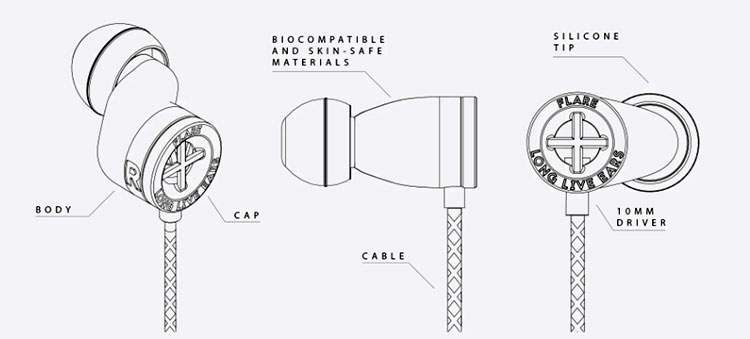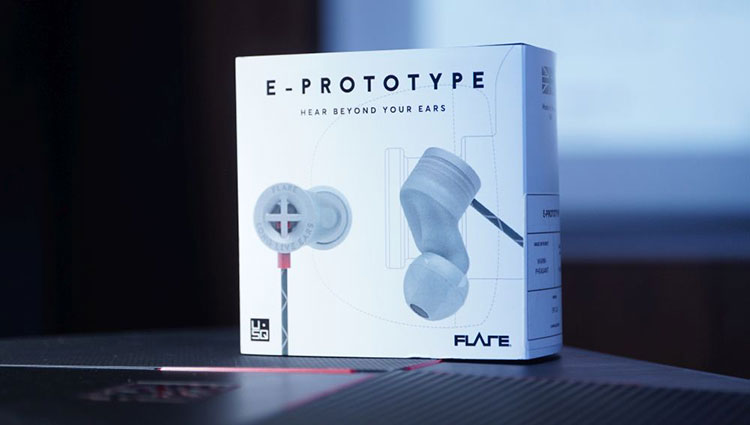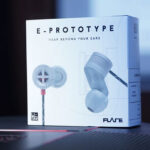Our review of the Flare Audio E-Prototype, which is a single 10mm dynamic driver universal IEM featuring USQ technology and a 3D printed design. It is priced at $344.
Disclaimer: This was sent to us as a sample for our honest opinion. Headfonics is an independent website with no affiliate links or services. We thank Flare Audio for this opportunity.
To read more on previous Flare Audio products on Headfonics you can click here.
Note, this article follows our latest scoring guidelines which you can read up on here.
Color me a Flare Audio enthusiast. Years ago, they thrilled me with the R2A and R2Pro series IEMs, which landed them among the best IEMs for the money at the time. Since then, they’ve steadily released a few models such as the Flares Pro and Pro 2 and each was well regarded.
Today, though, marks a different era. An era specifically engineered to reset the multiverse of audio driver technology…or so they claimed.
The E-Prototype
The E-Prototype is Flare Audio’s newest kid on the block so probably the best way to kick off the review is from a comment from Davies Roberts of Flare Audio regarding the idea behind this new IEM.
“‘Flare’s goal has always been to innovate in order to create mirror image sound quality so that artists, producers, and listeners can all enjoy creating and listening to music with the same level of incredible detail from the recording desk to the mobile phone.
Flare’s patent-pending USQ technology enables everyone to hear where the real issues are in tracks without any masking or distortion from the device.
We feel that this is an incredibly important step for the music industry to take as it will allow the industry to evolve sound quality into a mirror image and hyper-realistic sound quality future.”

Tech Highlights
The Driver
I literally can’t say anything about the actual technology of the E-Prototype and how it was made, or what it even physically is. The patent is still pending. Davies Roberts, the owner of Flare Audio, and I had a very long Zoom video call the day I received the package in the mail.
He wanted to have me unbox the E-Prototype live on stream and see my reaction to it, all while explaining more about the ongoings of the product itself. All I can tell you is that the E-Prototype driver is 10mm in size. I neither feel safe nor comfortable relaying much else that I learned about the dynamics of the driver and what it even is.
But what I can tell you is that this tech is going to beach the audiophile whale and force it to evolve on the spot or perish. I can safely tell you that if Davies wanted it, he could try to design this into a full-size headphone, using the same tech somehow, and obliterate the market. And to be honest, I hope he does it if it is even possible in a larger capacity format later in the future.
Distortion Reduction
The entire name of the game here is to reduce distortion as much as possible, that is their ultimate goal. Davies has told me that he found a way to reduce internal distortion to near 0 and relay the track nearly if not totally perfect as it was intended to be heard.
I have no way to actually test this beyond my own ears, so off I go to record some instruments of me playing with mediocre recording gear as best that I can muster.
I am not out for fidelity here; I am trying to see if the recording plays through the E-Prototype as close to how this cello and guitar feel to my ear with no recording going on. I want to gauge the physical traits and see if the E-Prototype adds bass bloom, or reduces it, as far as I am able to tell.
I realize my gear is limited and this is no official science-based test. But I should be able to at least feel and hear the bass and treble quantity through the E-Prototype vs what my ear naturally picked up while recording.

Test Case
So, I pluck my guitar low-E and play it back through the system and into the E-Prototype and it gets it very close. The natural reverb of the low bass string feels good. Swap out the E-Prototype for a few other IEM’s and the experience is very different.
Swap to the HD800 full-size headphone and it is like I didn’t even pluck the bassist string at all. I pick up my dad’s bass guitar and repeat the process and notice that the E-Prototype simply picks up more bass in the track than the other IEM’s I have at the moment (which I will cite later).
So, what does this mean? Does this mean that what I thought previously was accurate, wasn’t actually? And that the E-Prototype is the new baseline benchmark for what is accurate and what isn’t?
I am so used to not hearing that much bass in my recordings that I forget that the actual bass guitar and cello sounds MUCH more bassy in real life than it does through the headphones of my own recording. But that isn’t so much an issue with the E-Prototype. So, does that mean Davies achieved it? I’ll let other buyers testify their opinions on this subject.
Design
This E-Prototype is a total reversal of what I thought it was going to look like before I opened the package, and I wish I had recorded our Zoom meeting so others can see my reaction. I just wasn’t thinking, sorry about that.
Anyway, the exterior is 3-D printed in-house by a special robot(s). Your box will tell you the name of the robot that made your IEM, as well as who handled the package for you. Awesome.
Mine was made by Robot: Warm Pheasant. And Naomi tested and handled my IEM prior to packaging. I have never met Naomi nor Davies before, despite working with them for neigh 6 years now. It was great to say hi and see everyone through Zoom.
3D printed build quality was used specifically by the company due to highly customizable interior design needs. I would suppose it is much harder to etch out aluminum in a very specific and calculated way than it is to 3D print.
If you hadn’t also noticed, the IEM is shaped like the inner ear canal and not a bullet, or at all a classic over-ear housing styling. The material is cited as a biocompatible non-toxic polymer.
From a build standpoint, it is less sturdy, of course, than metal material. But I foresee no issues in fragility with 3D composition material. The cable is fairly standard and so is the 3.5mm adapter, nothing to gloss over.
Comfort & Isolation
I think this is the best fitting IEM I’ve ever worn that wasn’t a custom fit to my ear. The odd styling is really firm fitting for me, it doesn’t budge when I walk around or even snack on something.
IEMs are hit and miss for me; it has always been that way with regard to fit issues. I generally don’t fit with bullet-style IEMs, but the over-the-top of my ear style fits 50/50 as well as its own sub-tier of fitting issues.
So, it was a real pleasure for me to just sit there for hours on the first usage after the Zoom call and just chill out. Coffee in hand, cat purring nearby. I didn’t stop listening until the sun went down a few hours later and then suddenly it was midnight and I was still there.
I didn’t adjust them once (disregarding when I went to the restroom, of course, and left them in the listening area). For me, subjectively, the lighter material that is 3D printed is becoming more and more enjoyable than metal.
The E-Prototype isolation qualities are fairly passable for me, due to the good fit and seal. They are not really intended to be noise suppressing. Flare Audio has lots of products that can help with that. Check out the Flare Isolate, which I use every night when I go to bed.
I use the original generation of them, and they are still going strong. But those aren’t IEM’s, they are just earplugs. Anyway, the E-Prototype is just ok at isolating qualities and blocks some noise passively. I don’t think the 3D printed material does too much for passive noise suppression.
Stock Cable
The E-Prototype stock cable is about 1.3m long and intended for portable usage with your phone. It has a mic-enabled switch on the cable for calls. I ran into a funny problem trying to get the E-Prototype to work on my expensive desktop amps and found out that they don’t let me use mic-enabled cables on them.
I laughed at myself. I dropped on a cheap 3.5mm splitter and perfecto, no problem running this on an amplifier that wasn’t made to be used with a mic cable.
As for quality, the cable is standard, at least, in my opinion. Sure, I’d rather have a nicer fabric lacing. To me, that invokes a higher sense of quality overall than a rubberish exterior casing. But it certainly is not intrusive, I don’t detect any microphonics issues, so it gets a pass.
The 3.5mm adapter is also gold plated, with no balanced options. You won’t need it and I understand why they don’t have one. More on that in a second though.
Flare Audio is all about evolving and pushing the boundaries of what is possible, innovation is what they do. So, yea, I did want to see some cable innovation, or at least something different than the past few models.
Packaging & Accessories
My E-Prototype package came with a relatively small and unassuming package inside of another box which contained yet another box which then contained a nice hard case, and that case contained the IEM’s all snug looking. Your purchase will include a standard Flare Audio portable hard case. You can buy a spare here for just $11.
Beyond that, nothing but 3 different ear tip sizes. The standard fair, small, med, large. I prefer the medium, they fit my ear the best and also offer the best sound seal for my ear shape.
The large set can’t achieve a seal and just pop out due to being too large, and the reverse happens with the small, they are too small to seal properly without pushing them in deeper than I feel comfortable with.
They also go loose fast for me, so the medium tips it is! You also get a small little card from the owner thanking you and letting you know good things are about to be heard.
Click on page 2 below for sound impressions and select comparisons







